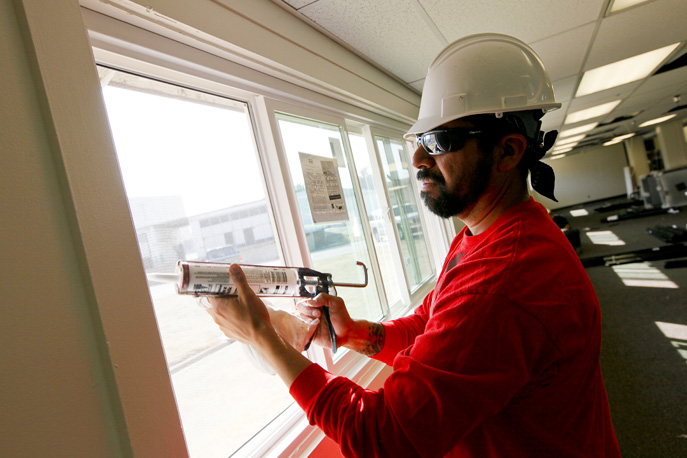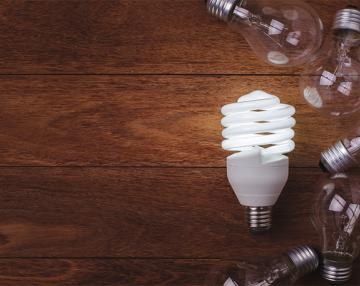What is energy efficiency?
Energy efficiency is simply about reducing waste. Energy efficiency aims to decrease the amount of energy required to provide products and services through the use of improved technology and practices. By lowering the amount of energy needed for the same or greater service output, we reduce our reliance on fossil fuels needed to generate electricity. We also save money - and water.
According to the National Action Plan for Energy Efficiency, homes, businesses, schools, governments, and industries consume more than 70 percent of the natural gas and electricity nationally. Energy efficiency has the capacity to meet our increasing electricity demands when coupled with new generation and other supply options while simultaneously providing one of the fastest, most affordable, and easiest ways to address challenges over energy security and independence, climate change, and air pollution.


What are the benefits of energy efficiency?
There are numerous benefits to energy efficiency for Texans. These range from strengthening the economy, reducing the cost of running a business or household, to better public health through improved air quality.
Energy efficiency creates jobs directly through the installation of energy efficiency measures; skilled labor is required in the form of craftsmen and women, planners, engineers, and financiers to build and maintain projects within the public and private sector. Labor is needed to improve the efficiency of household appliances, such as boilers, and heating and cooling systems. Engineers and experts are required to install systems that optimize energy use, and capture and store wasted heat in order for it to be effectively used again. Similarly, jobs are created indirectly through increasing the demand for high-efficiency products within the manufacturing market.
Energy efficiency creates employment opportunities that draw from a variety of sectors, including construction, contracting, engineering, and maintenance. Through the nature of these jobs, many cannot be offshored, consequently increasing national job security.
Reducing the amount of energy required for products and services while simultaneously maintaining or enhancing the output results in economic gains lower energy bills. Additionally, if we can reduce energy use in particular times of the day -- such as the peak of a summer day -- there is a reduced strain on transmission lines. Indeed, by reducing peaks, we can eliminate the need for new transmission infrastructure.
Energy efficiency creates numerous health benefits. The top four causes of death in the United States are caused by air pollutants produced from fossil fuel combustion. These include cancer, chronic lower respiratory diseases, heart disease, and stroke. In addition to health problems, pollutants such as carbon dioxide, sulfur dioxide, nitrogen oxides, particulate matter, mercury, and lead are all by-products of fossil fuel combustion that cause environmental damage, including climate change, air pollution, and water contamination. Because our energy portfolio still includes fossil fuels like coal, lowering our energy demand results in less demand for fossil fuels and consequently, greater energy efficiency leads to a decrease in harmful pollution.
What is the state of energy efficiency in Texas?
Texas was the first state to establish an Energy Efficiency Resource Standard (EERS) in an attempt to develop a greater energy efficient economy. The original goal in 2004 was for investor-owned utilities (IOUs) -- the transmission and distribution companies -- to attain 10% of annual growth in electricity demand via energy efficiency. Through legislative action and lots of work by many stakeholders, these standards were updated in 2008 to 20% of annual growth and again in 2011 to 0.4 percent of summer peak demand. The Public Utility Commission of Texas reviews each utility’s annual goals and approves rate adjustments on how to accomplish them.
Unfortunately, over the last decade, Texas’ leadership has disappeared, and in recent years the amount of energy efficiency obtained by utilities has actually decreased. Over the past decade, legislative and regulatory policy changes have decreased participation and funding for efficiency programs, which allowed industrial and certain commercial customers to opt out of the efficiency program. In 2011, the The Texas Legislature and Public Utility Commission authorized caps on energy efficiency budgets. Consequently, budgets and energy efficiency programs have generally stagnated.
A total of 26 states have Energy Efficiency Resource Standards but Texas ranks the lowest in the country for EERS. According to information from the U.S. Department of Energy, EIA, and the State Energy Data System (SEDS), Texas consumes the most energy; in 2014, Texas consumed over a third more than California, the second largest consumer, due in part to saving less through energy efficiency. In 2012, Texas spent less per capita on energy efficiency than 39 other states.
In contrast to investor-owned utilities, many public utilities in Texas have made much greater investments. For example, Austin Energy, CPS Energy in San Antonio, Pedernales Electric Cooperative, Bluebonnet Electric Cooperative, and the Denton Municipal Electric all have robust energy efficiency programs for their customers.
Barriers to energy efficiency
If energy efficiency is so great, why isn’t everyone on board? Public policies are often needed for energy efficiency to overcome barriers for it to reach its full potential. Energy efficiency is often underutilized despite its proven benefits; according to The South-central Partnership for Energy Efficiency as a Resource (SPEER), a regional organization that aims to increase the implementation of energy efficient practices, energy efficiency could be implemented significantly more than it is currently to produce cost effective gains.
However, there is a lack of information about the efficiency programs within Texas. Indeed,: many investor-owned utilities have failed to notify all customers about the incentives, and, consequently, customers were unable to benefit from the program and had no clear pathway to greater efficiency. Moreover, funding for efficiency programs has been small, resulting in limited customer outreach. Similarly, the scale of the utility program was also small which meant the likelihood of success of delivering efficiency to new customers was also low.
Unfortunately, energy efficiency is still regarded as an abstract resource. It is hard to measure the demand and effectiveness of some energy efficiency measures. Consequently, it does not seem to fit the current energy market from a policy perspective.
In addition, while building owners and homeowners often have an incentive to invest directly into their homes and businesses to reduce utility bills, those who rent their homes or lease their businesses often have a “split-incentive” issue. That is, they don’t own the building but they pay the bills. This makes it difficult for these “renters” to invest in energy efficiency.
Moreover, while energy efficiency investments do save money over time, often the initial expense is a barrier, especially for working Texans. Most utilities have some money available for “free” weatherization, but these programs are small, and most traditional rebate programs only cover a small part of the cost of more efficient lighting or air conditioning.
One Bright Spot: New Construction
No state builds more homes or new commercial buildings than Texas. Fortunately, the state has been a leader on adopting modern efficiency standards for new construction. Most recently, due to legislative and administrative action, Texas required its cities to update their energy codes for new construction to the equivalent of the 2015 International Energy Conservation Codes. Several cities, including Houston and Austin, have traditionally passed local amendments to make their new construction even more energy efficient. Similarly, the state of Texas also requires new buildings to meet energy efficiency (and water conservation) standards. These new 2015 standards are 10-20 percent more energy efficient that the previous standards. According to SPEER, about 60 percent of Texans live in cities that have already updated to the new standards.
Another Bright Spot: New Financing Mechanism for Energy Efficiency
Texas counties and cities now have a new financing tool for energy efficiency and onsite renewable energy called Property Assessed Clean Energy (PACE). PACE Districts are now operating in Houston, Austin, Dallas, Fort Worth, and many other cities and counties. Under the program, private funders lend money to a business owner, who pays it back as a special assessment on their property taxes. This way, even if a business changes hands, the loan will still be paid back.
How Is Sierra Club Involved in Energy Efficiency?
The Sierra Club is involved in advocating for energy efficiency at the local and state levels as well as through engaging directly with utilities.
- We continue to advocate for updating building code standards throughout the state, and work with the state and cities to ensure codes are implemented and enforced. We are working to make our building codes “solar-ready” too so that new buildings can easily add solar.
- We are urging the PUC and state leaders to reform the EERS program to increase funding and goals for investor-owned utilities like Oncor and Centerpoint. We are also working to increase commitments and funding to energy efficiency programs in public utilities.
- We are also working on financing, including through on-bill financing as well as through the PACE Districts.
- Within ERCOT (the state grid operator), we are working to allow electric loads to participate in the energy market through “demand response” programs. These are programs that allow energy users to shift their peak use, and sell the “excess” energy into the grid. Demand response programs can be used for both emergency response programs when the grid is stressed, or hopefully, as an actual bid into the energy market.
What can people do to learn more or to get involved?
At the household level, there are a number of simple steps you can follow to become more energy efficient. Holes and cracks around windows, doors, light and plumbing fixtures, switches, and electric outlets can be sealed to banish air leaks. Using less hot water while turning down the water heater thermostat and using power saver modes on personal electronic items can all be cheap ways to save energy.
Additionally, if you can invest in more substantial energy efficiency measures, insulation in attics, exterior walls, ceilings, floors, and crawlspaces can be implemented and improved; energy-efficient windows, lighting and water heaters can be installed; hot water pipes can be insulated, and regular maintenance on the heating, ventilation and air conditioning units can be scheduled in order to maximize the effectiveness and efficiency. These are all great ways to increase your energy efficiency, which can save you money while helping the planet.
Before you get started, though, learn about what local policies, incentives, and programs exist in your area. A good place to start is DSiRE – a database of state incentives for renewables and efficiency. Similarly, SECO provides a range of additional information, including state and local funding and incentives.
Finally, your elected officials need to know you care about energy efficiency! Find out who represents you here, and reach out to them!